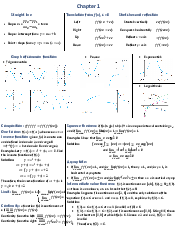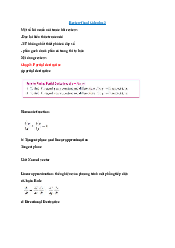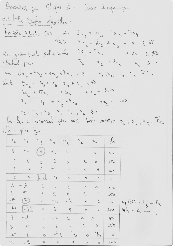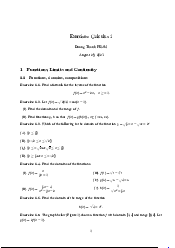



Preview text:
INTERNATIONAL UNIVERSITY-VNUHCM FINAL EXAMINATION
Semester 3, Academic Year 2015-2016 Duration: 120 minutes SUBJECT: Calculus 2
Chair of Department of Mathematics Lecturers: Signature: Signature:
Full name: Assoc.Prof. Nguyen Dinh
Full names: Assoc.Prof. Mai Duc Thanh
• Each student is allowed a maximum of two double-sided sheets of reference
material (of size A4 or similar) and a scientific calculator. All other documents
and electronic devices are forbidden.
• Each question carries 20 marks.
Question 1. a) Find the first partial derivatives of the function f (x, y) = e4x−y2.
b) Find the directional derivative Duf (x, y) of the function f (x, y) = e4x−y2 at the point √ √
(1, 2) in the direction of the vector u =< 1/ 2, −1/ 2 >.
Question 2. Find the local maximum and minimum values and saddles point(s) of the function f (x, y) = ex(x2 − y2).
Question 3. a) Evaluate the double integral Z Z √ I = 2y dA,
D = {(x, y) | 0 ≤ x ≤ 1, x2 ≤ y ≤ x}. D
b) Find the volume of the solid under the surface z = 1 + 2xy and above the region in the
xy-plane bounded by y = 1 − x and y = 1 − x2.
Question 4. a) Evaluate the triple integral Z Z Z x dV,
E = {(x, y, z) | 0 ≤ x ≤ 1, 0 ≤ y ≤ x, 0 ≤ z ≤ x + 2y}. E b) Evaluate the line integral Z (2x2 − y) dx + 2y dy C
where C is the arc of the curve y = x2 from (0, 0) to (2, 4).
Question 5. Let a vector field F(x, y, z) = xyi + yj + zk be given.
a) Evaluate the line integral R F · dr, where C has the parametric equations x = t, y = C t2, z = et, 0 ≤ t ≤ 1.
b) Evaluate the surface integral RR F · dS, where S is the part of the paraboloid z = S
16 − 3x2 − 3y2 that lies above the rectangle 0 ≤ x ≤ 2, 0 ≤ y ≤ 1. 1 SOLUTIONS OF FINAL EXAM Subject: CALCULUS 2
Question 1. a) Find the first partial derivatives of the function f (x, y) = e4x−y2. fx(x, y) = 4e4x−y2 fy(x, y) = −2ye4x−y2.
b) Find the directional derivative of the function f (x, y) = e4x−y2 at the point (1, 2) in the √ √
direction of the vector u = (1/ 2, −1/ 2). √ √ √
Duf (x, y) = ∇f(x, y) · u =< 4, −4 > · < 1/ 2, −1/ 2 >= 4 2
Question 2. Find the local maximum and minimum values and saddles point(s) of the function f (x, y) = ex(x2 − y2). Partial derivatives
fx(x, y) = ex(x2 − y2 + 2x) fy(x, y) = −2yex Critical points:
fx(x, y) = ex(x2 − y2 + 2x) = 0 fy(x, y) = −2yex = 0 or y = 0, x(x + 2) = 0
so that x = 0 or x = −2 and y = 0. So, there are two critical points (0, 0) and (−2, 0). Second partial derivatives:
fxx(x, y) = ex(x2 − y2 + 4x + 2), fxy(x, y) = −2yex, fyy(x, y) = −2ex. Consider
D = fxx(x, y)fyy(x, y) − (fxy(x, y))2. At M1(0, 0), it holds
D = fxx(0, 0)fyy(0, 0) − (fxy(0, 0))2 = 2(−2) − 0 = −4 < 0, so (0,0) is a saddle point. At M2(−2, 0) it holds
D = fxx(−2, 0)fyy(−2, 0) − (fxy(−2, 0))2 = e−4(−6)(−2) − 0 = 12e−4 > 0
and fxx(−2, 0) = −6e−4 < 0. So f(−2, 0) = 4e−2 is a local maximum value. Question 3. a) √ √ Z 1 Z x Z 1 y= x 2y dy dx = y2 dx 0 x2 0 y=x2 Z 1 1 =
(x − x4)dx = (x2/2 − x5/5) = 1/2 − 1/5 = 3/10. 0 0 2 b) The volume is given by Z Z V = (1 + 2xy) dA,
D = {(x, y)|0 ≤ x ≤ 1, 1 − x ≤ y ≤ 1 − x2}, D Therefore Z 1 Z 1−x2 V = (1 + 2xy)dydx 0 1−x Z 1 y=1−x2 = (y + xy2) dx 0 y=1−x Z 1 =
[1 − x2 + x(1 − x2)2 − (1 − x) − x(1 − x)2]dx 0 Z 1 =
[1 − x2 + x(1 − 2x2 + x4) − (1 − x) − x(1 − 2x + x2)] 0 Z 1 1 =
(x5 − 3x3 + x2 + x)dx = (x5/5 − 3x4/4 + x3/3 + x2/2) = 17/60 = 0.2833. 0 0
Question 4. a) Evaluate the triple integral Z Z Z x dV,
E = {(x, y, z) | 0 ≤ x ≤ 1, 0 ≤ y ≤ x, 0 ≤ z ≤ x + 2y}. E Z Z Z Z 1 Z x Z xdV = 0x+2yxdzdydx E 0 0 Z 1 Z x Z 1 Z x = x(x + 2y)dydx = (x2 + 2xy)dydx 0 0 0 0 Z 1 Z 1 x = (x2y + xy2) dx = 2x3dx 0 0 0 1 = x4/2 = 1/2 0 b) Evaluate the line integral Z (2x2 − y) dx + 2y dy C
where C is the arc of the curve y = x2 from (0, 0) to (2, 4).
We have y0 = 2x, 0 ≤ x ≤ 2. Thus, Z Z 2 (2x2 − y) dx + 2y dy = [(2x2 − x2) + 2x22x] dx C 0 Z 2 2 =
(4x3 + x2) dx = (x4 + x3/3) = 23(2 + 1/3) = 56/3 = 18.67. 0 0
Question 5. Let a vector field F(x, y, z) = xyi + yj + zk be given.
a) Evaluate the line integral R F · dr, where C has the parametric equations x = t, y = C t2, z = et, 0 ≤ t ≤ 1. 3
Vector equation of C: r(t) =< t, t2, et >, 0 ≤ t ≤ 1. We have r0(t) =< 1, 2t, et >, and
F(r(t)) =< t3, t2, et > . Thus Z Z 1 F · dr = F(r(t)) · r0(t)dt C 0 Z 1 Z 1 = (t3 + 2t3 + e2t)dt = (3t3 + e2t)dt 0 0 1
= (3t4/4 + e2t/2) = 3/4 + e2/2 − 1/2 = e2/2 + 1/4 = 3.9445 0
b) Evaluate the surface integral RR F · dS, where S is the part of the paraboloid z = S
16 − 3x2 − 3y2 that lies above the rectangle 0 ≤ x ≤ 2, 0 ≤ y ≤ 1.
Set F(x, y, z) =< P, Q, R >, where P = xy, Q = y, R = z, and S is given by z = g(x, y) =
16 − 3x2 − 3y2. Applying the formula Z Z Z Z F · dS = (−P gx − Qgy + R) dA S D Z Z =
[−xy(−6x) − y(−6y) + (16 − 3x2 − 3y2)] dA D Z Z = (6x2y + 3y2 − 3x2 + 16) dA D Z 2 Z 1 = (6x2y + 3y2 − 3x2 + 16)dydx 0 0 Z 2 1 =
(3x2y2 + y3 − 3x2y + 16y) )dx 0 0 Z 2 Z 2 = (3x2 + 1 − 3x2 + 16)dx = 17dx = 34 0 0 4




